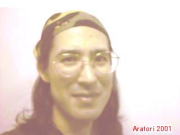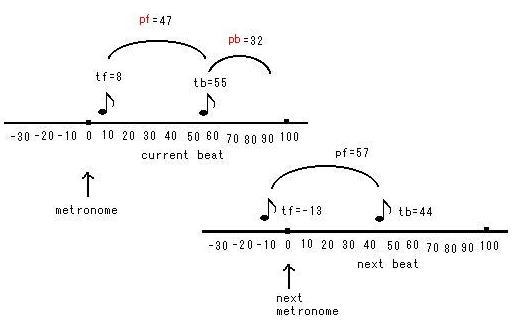



| Welcome page (Outline including 10 seconds of sound sample) |
Ohter Languages |
Questions The Aim |
What is bounce? (What is swing?) Why do we need timing fluctuation? What is improvisation? How do we listen and play, or perceive unnotated timing? This site timing-progression.com seeks these questions by means of mathematics, philosophy as well as, of course, decades' practice. |
Unnotated timing |
TP |
Welcome to timing-progression.com presented by Aratori (jazz keyboarder). If you are a musician or a listener, who is interested in the improvisational music or jazz invented at the middle of the 20th century, timing progression (TP) may provide new perspective for you. TP, I (Aratori) claim, is the essence of the invention of jazz and can not only intensify swinging feeling but also constitute music even without chord progression. |
 Aratori, jazz keyboarder |
| What is TP? |
While chord progression individuates and constitutes music by making use of sequence of harmony, TP does by making use of sequence of unnotated timing. | NOTE 1, Aratori's idea |
| Listen to TP music MP3 |
Download and listen to TP music. (Any of this site's sound data is download-free. Virus
free. Checked by Virus Buster.) Click below. The first 8 bars of "timing-progression.com Aratori Vol. 1" MP3 (128kbps) 0:00:13 207KB (If you release MP3 from Windows Media Player, you can download it.) |
TP music More sound |
TP proportion graph |
Let's see timing fluctuation of the sound above as you listen to the downloaded MP3 file. Figure 1 is TP proportion graph. Proportion, which is one of the most important properties of TP, is exemplified in Figure 2 below.  Figure 1 TP proportion graph of first 8 bars of "timing-progression.com Aratori Vol. 1" Black point is pf, red one is pb. '10' is equivalent to about 30ms. |
NOTE 2, perceiving TP TP proportion graph Proportion Enlarge Figure 1 (big size) Enlarge Figure 1 (medium size) |
| Proportion |  Figure 2 Example of timing and proportion |
one metronome beat = 100 (defined) tf: timing of front eighth note tb: timing of back eighth note pf: proportion of front eighth note pb: proportion of back eighth note bl=pf+pb =beat length |
| You will find how the timings fluctuate. There is no fixed ratio or length
of them. Then, how is this orderly, structured and swinging-feeling bounce?
Can you do solfeggio the proportions of eighth notes by ears? Can you imagine
in your mind or hum the proportions of them? Why do we, on the contrary,
take them as 'eighth notes' regardless of having considerable timing fluctuation?
|
Solfeggio TP? Imagine TP? Philosophical problem |
|
| Unnotated timing symbol | The bounce is yielded not by notated symbol but by unnotated timing symbol, which can not be transcribed into score. The symbol, historically and socially regarded as ephemeral and contingent, has not been analyzed compared to notated symbol, which is transcribed into score. First, there has been no device for identifying it. | Notated symbol Unnotated timing symbol ,NOTE 3, symbol |
| Telescope Piano MIDI |
In the 17th century, a new device telescope made Galileo Galilei be able to strongly present the concept "And yet it [the earth] does move". The telescope was the device which relativized the earth and satellites. In the 18th century, a new instrument piano (pianoforte), which had piano/forte and resonant sound with stable pitch, made score music blossom. It can be said that piano was a device to identify the sound corresponding to scores. At the middle of the 20th century, the spread of sound recording/representing devices prompted the invention of jazz. They conveyed jazz feelings and now convey a huge amount of music enough to bore us. And at last, in 1990's, MIDI system, which can record, measure and reproduct precise (unnotated) timing, began to be available. Don't you naturally think the new device will help us to bear new concept of music? If so, new concept must be about the sound corresponding not to scores. | Identification of score sound Identification of TP sound? |
| The device is necessary but, of course, not sufficient. In the next place, there has been no experimental music which takes unnotated timing symbol as constitutive and regard other symbol as contingent. Now, I claim that is TP music, which needs decades' practice for playing and 100,000-times listening for perceiving TP. Though we may be forced to think present sciences are developing so rapidly, our perception and understanding for utterly new realm improves as slowly as it did in Galileo's era. | TP music as experimental one |
|
Unnotated timing perception |
We are now at the departure of the long road seeking the riddle of bounce and unnotated timing. TP wants you, who may be a listener, musician, mathematician, philosopher or brain science researcher. Let's join experiments of unnotated timing perception! |
| NOTE 1 Aratori's idea |
Every jazz musician must know that subtle rhythm takes part in induviating jazz music. But the idea, by means of decades' experiment (practice) of methodology, of distinguishing from other notated symbol, prompting and naming the function (TP) of, and trying to research the riddle of 'unnotated timing symbol', is Aratori's. |
| NOTE 2 Perceiving TP |
If you have trouble in perceiving TP while looking TP graph, it suggests that such sense of sight or analyzing attitude conflicts with the perception of unnotated timing. | MORE to Method |
| NOTE 3 Symbol |
I use "symbol" like Nelson Goodman's use: "as a very general and colorless term. It covers letters, words, texts, pictures, diagrams, maps, models, and
more, but carries no implication of the oblique or the occult. The most
literal portrait and the most prosaic passage are as much symbols, and
as 'highly symbolic', as the most fanciful and figurative" (Languages
of Art, p.xi). We can not perceive anything without the function of symbol. |
Copyright 2002-2005 Aratori